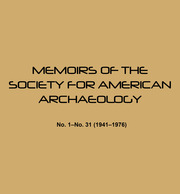No CrossRef data available.
Article contents
5 Summary Definition of the Issaquena Phase
Published online by Cambridge University Press: 27 June 2018
Extract
The Issaquena phase is postulated as a discrete culture unit identified at four sites in the southern part of the Yazoo Basin in the Lower Mississippi Valley. The primary criteria distinguishing this culture unit are a number of pottery types within a Lower Mississippi Valley ceramic tradition. The four marker types are: Manny Stamped, characterized by medium-sized open bowls with thickened rims, and decorated by zoned, dentate rocker-stamping outlined by deep U-shaped incisions on the exterior; Yokena Incised, with similar forms, but decorated by bold designs without background roughening; Troyville Stamped, again with the basic open bowls, but decorated with zoned non-dentate rocker-stamping; and Churupa Punctated, a type closely related to the other three but decorated by zones of hemiconical punctations outlined by the above-described type of incised line. These ceramic groups have prototypes in the preceding Marksville phase, apparently centered somewhat to the south in the Lower Mississippi Valley. It may be noted here that all of the pottery of the Issaquena phase has come from occupation deposits and thus may be construed as utility ware.
- Type
- Research Article
- Information
- Copyright
- Copyright © Society for American Archaeology 1964


